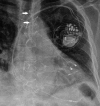Fracture of an epicardial left ventricular lead implanted at open-heart surgery in anticipation of future need for cardiac resynchronization therapy
- PMID: 32128194
- PMCID: PMC7044377
- DOI: 10.1002/ccr3.2669
Fracture of an epicardial left ventricular lead implanted at open-heart surgery in anticipation of future need for cardiac resynchronization therapy
Abstract
Epicardial left ventricular leads can be implanted at open-heart surgery for cardiac resynchronization therapy. We report a 2-year-old fractured epicardial left ventricular lead detected at generator implant. It highlights the importance of good surgical implant technique and of rigorous lead evaluation for signs of impending failure at generator implant.
Keywords: cardiac resynchronization therapy; epicardial lead; lead failure; open‐heart surgery.
© 2020 The Authors. Clinical Case Reports published by John Wiley & Sons Ltd.
Conflict of interest statement
None.
Figures



Similar articles
-
Epicardial left ventricular lead placement for cardiac resynchronization therapy: optimal pace site selection with pressure-volume loops.J Thorac Cardiovasc Surg. 2004 Jun;127(6):1641-7. doi: 10.1016/j.jtcvs.2003.10.052. J Thorac Cardiovasc Surg. 2004. PMID: 15173718
-
Utility of echocardiographic tissue synchronization imaging to redirect left ventricular epicardial lead placement for cardiac resynchronization therapy.Chin Med J (Engl). 2013 Nov;126(22):4222-6. Chin Med J (Engl). 2013. PMID: 24238501
-
Epicardial leads in adult cardiac resynchronization therapy recipients: a study on lead performance, durability, and safety.Heart Rhythm. 2015 Mar;12(3):533-539. doi: 10.1016/j.hrthm.2014.11.004. Epub 2014 Nov 7. Heart Rhythm. 2015. PMID: 25460170
-
Advanced left-ventricular lead placement techniques for cardiac resynchronization therapy.Curr Opin Cardiol. 2014 Jan;29(1):53-8. doi: 10.1097/HCO.0000000000000028. Curr Opin Cardiol. 2014. PMID: 24284980 Review.
-
Epicardial left ventricular lead for cardiac resynchronization therapy.Neuro Endocrinol Lett. 2014;35 Suppl 1:34-9. Neuro Endocrinol Lett. 2014. PMID: 25433352 Review.
References
-
- Cleland JGF, Daubert J‐C, Erdmann E, et al. The effect of cardiac resynchronization on morbidity and mortality in heart failure. N Engl J Med. 2005;352:1539‐1549. - PubMed
-
- Moss AJ, Hall WJ, Cannom DS, et al. Cardiac‐resynchronization therapy for the prevention of heart‐failure events. N Engl J Med. 2009;361:1329‐1338. - PubMed
-
- Rickard J, Johnston DR, Price J, et al. Reverse ventricular remodeling and long‐term survival in patients undergoing cardiac resynchronization with surgically versus percutaneously placed left ventricular pacing leads. Hear Rhythm. 2015;12:517‐523. - PubMed
-
- Chen L, Fu H, Pretorius VG, et al. Clinical outcomes of cardiac resynchronization with epicardial left ventricular lead. Pacing Clin Electrophysiol. 2015;38:1201‐1209. - PubMed
-
- van Dijk VF, Fanggiday J, Balt JC, et al. Effects of epicardial versus transvenous left ventricular lead placement on left ventricular function and cardiac perfusion in cardiac resynchronization therapy: A randomized clinical trial. J Cardiovasc Electrophysiol. 2017;28:917‐923. - PubMed
Publication types
LinkOut - more resources
Full Text Sources

